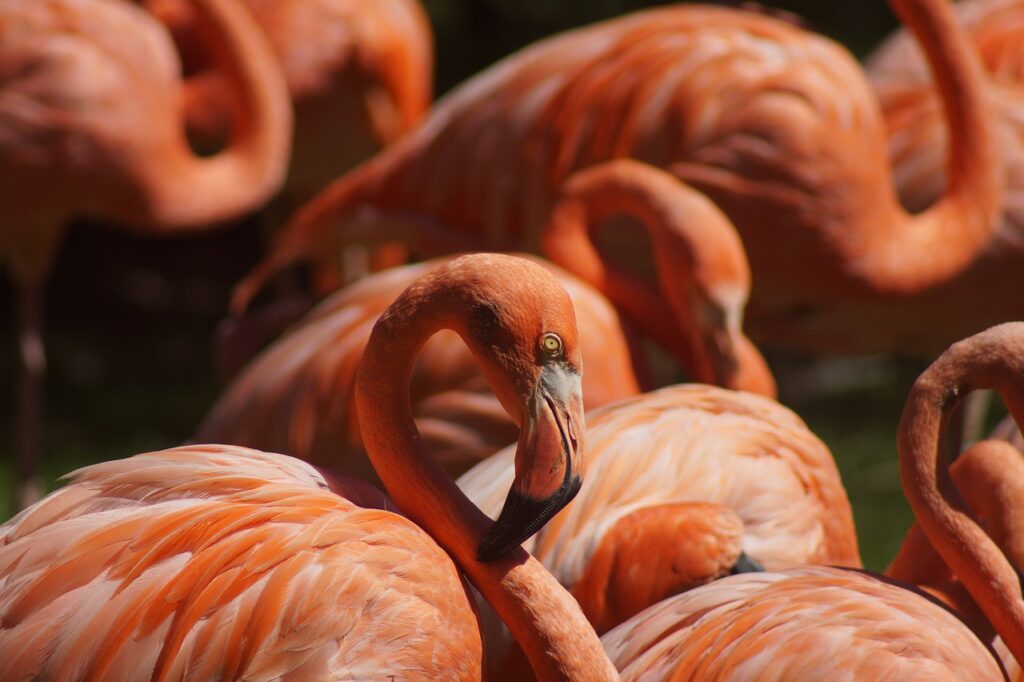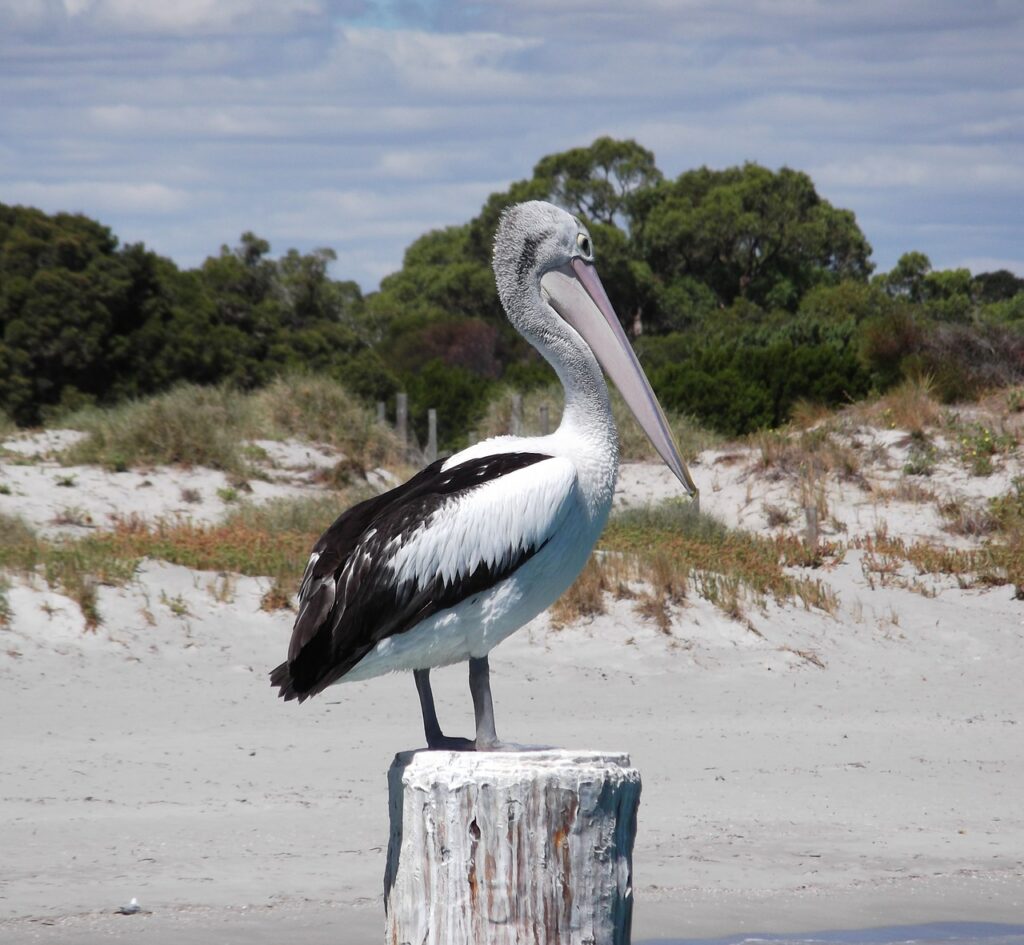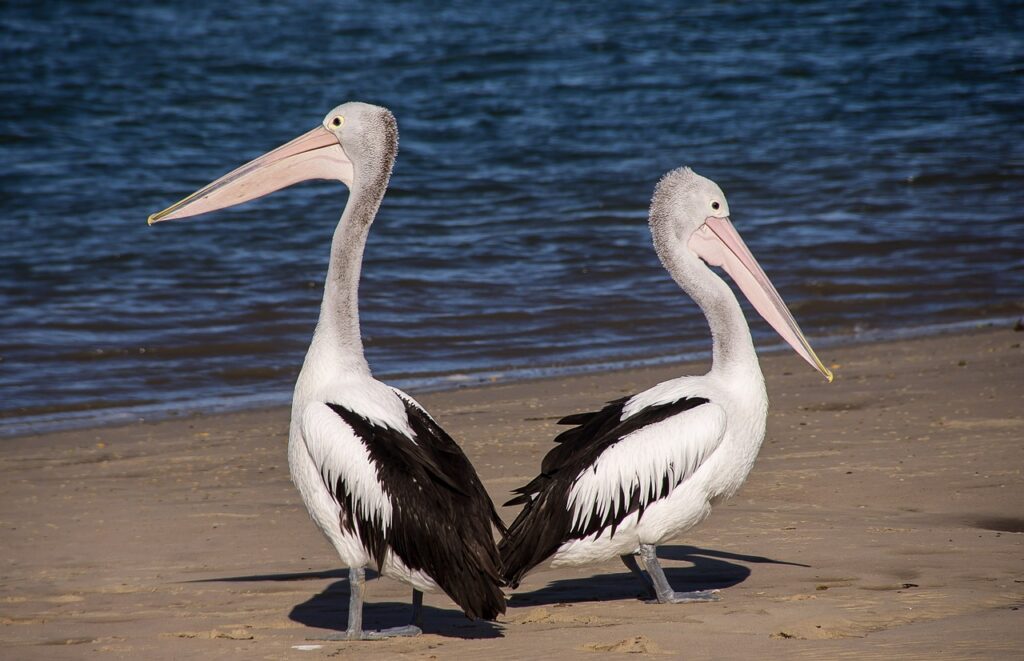So, What’s The Difference Between Flamingos And Pelicans?
Well, these two large and magnificent birds are often seen close to the edge of great lakes and the ocean – although only one of them will try to steal your lunch! They both have very different lifestyles and habits – and aren’t often seen in the same waters or doing the same things. Let’s take a close look at what makes flamingos and pelicans so very different.
5 Ways To Tell Flamingos And Pelicans Apart:
1: Color – Flamingos are famously pink in color – pelicans are rather duller
2: Bills – Flamingos have a very strangely-shaped bill – a pelican is more of a bucket
3: Water Habits – Flamingos only wade but pelicans bob
4: Lifestyle – Pelicans feed alone or in small groups – flamingos love a crowd
5: Long Legs – Flamingos have the longest legs
These differences are enough for any casual observer to tell them apart. No pelican is ever pink – but sometimes flamingos can be grey or white – so let’s drill down into all the differences listed to get a better picture of who is who.
1: Flamingos And Pelicans Are Completely Different Colors
Flamingos are world-famous for their extravagant plumage – they are perfectly pink. Their entire body – head, neck, and wings – are all covered in bright pink feathers – maybe with a touch of black or white. However, if fed the wrong foods or ill, a flamingo can lose its pink color and become white or gray. Young flamingos are gray too.

Two pelicans are white (the American White and the Great White). Whatever color they are on their body, through – all species of pelican have huge bills that are pink or yellow – except the Brown Pelican – whose bill is grey. On the other hand, Pelicans are usually black and white or pale gray with a touch of yellow on the faces of some.

2: Flamingo And Pelican Bills Are Very Specialised
Both flamingos and pelicans have evolved very specialized – and very different – bills. Depending on their favorite foods, they have changed the way they feed over the centuries to best catch and process. Pelicans are almost entirely piscivores – eating a diet of fish caught in the water. And their method of catching them is with a net of sorts. Having a giant bill – over a foot long – with a fully expandable bottom jaw pouch, you can’t mistake these greedy guts.
Flamingos went an entirely different way for a sea bird and chose to eat only the smallest things in the water. They are omnivorous and eat the tiniest plants and crustaceans. They evolved an extraordinary bill that allows them to filter out these tiny life forms from the water – upside-down! When held the right way up, it looks bent, but it is perfect for skimming the water’s surface when held upside-down.
3: One Float And One Wades
Pelicans are mainly seen in the water floating on the surface like most modern ducks and swans. While not feeding, they are safer out on the ocean and float around to rest and recuperate. Their feeding dives take a lot of energy – as does squabbling with the other pelicans afterward. They will also feed on land occasionally, although this isn’t natural and is more a learned behavior for scavenging from humans.
You won’t see a flamingo sitting on the water like a duck, though – they don’t float around on the lakes and lagoons they feed in for two main reasons. Firstly, their legs are too long. Like herons and storks, they aren’t designed to float around in deep water – wading is their thing. And secondly, the waters that flamingos wade in are often highly corrosive as they are filled with salt. This water would seriously damage feathers and burn the skin – so they stick to standing on their anti-corrosion legs.
4: Groups Of Flamingos Can Far Outnumber Pelicans
If you have ever seen flamingos – you know they love a gathering. Lesser Flamingos (the most numerous of all flamingos) can gather in groups of several thousand in Africa. Although they are the smallest species of flamingo – they make up for it in crowds. Other species are found in more modest groups – but there are always many individuals – especially during the mating season.
Pelicans would ideally like to be alone at feeding time – so they get the most fish to themselves. However, they still gather in small groups for most things – although nowhere near the numbers of feeding flamingos. Pelicans will steal food off each other when hunting – and have it stolen by other birds (usually seagulls stealing fish from literally out of their mouths). However, at nesting time, pelicans can form huge colonies numbering in the hundreds either on land or in the trees (in the case of the Spot-Billed Pelican).
5: Both Birds Have Different Length Legs
Due to their different lifestyles – they both need different length legs. Flamingos need to be able to safely wade in dangerous waters for their food, so their legs need to be long enough to keep them clear of any splashes. The longer their legs got – the longer their neck had to grow to still reach the water. Both their necks and legs can be over a foot long on either side of their body – quite a sight when in flight.
On the other hand, pelicans don’t need their legs to keep them out of the water – they like to float in it. They also dive underwater for their food, so they need shorter, more powerful legs to propel them beneath the waves. They can still walk on land with shorter legs, but like most waterfowl – it is more of a waddle.
Frequently Asked Questions
Why Are Flamingos Pink?
Amazingly, flamingos are only pink because of something in their food – their feathers are white without it. Carotenoids are found in their food – plankton – and this is what stains their plumage creating their famous outfits. Flamingos in zoos began to lose their vivid appearance when their diet lacked this, but now the process is better understood.
Why Do Pelicans Have Such A Big Mouth?
Birds of all kinds gradually evolve to become better at doing something – and they tend to go with what was successful at the time. The pelicans chose to catch their fish by scooping them up – like tiny whales – rather than stab at them like other seabirds such as gannets. The cost of this scooping up is the weight of a far larger bill, but they will often work together with other pelicans to catch more food.
Can Pelicans And Flamingos Have Babies?
Pelicans and flamingos are both birds – but are so far apart genetically that it would be almost impossible for them to breed with each other naturally. Flamingos are related to grebes – and pelicans are closest to shoebills and herons – so not even close. They also have different mating rituals, so they wouldn’t find each other a compatible mate in the first place.
Why Do Flamingos Stand On One Leg?
You always see flamingos resting or sleeping on just one leg and think, how does that work? Well, scientific studies have found that a flamingo is more stable on one leg and uses less energy that way. They also say that standing on one leg can help keep the body warm, seeing as always wading in really cold water. But whatever benefit it confers – it must be worth it because they all stand on one leg – and for hours.
Questions And Answers
Question: Can Flamingos Be Blue?
Answer: Not in the wild using the natural ability of the flamingo. It only reacts to this one compound. It is possible to dye a flamingo blue – but who would want to do that? There was once a black flamingo seen in Africa, though.
Question: Do Pelicans Eat Pigeons?
Answer: There are many videos and stories about pelicans catching pigeons in their giant mouths and eating them – and they are certainly true. In urban areas, pelicans and pigeons are in great numbers and often frequent the same areas – so this will become more and more common.
Question: Do Pelicans Attack Humans?
Answer: Yes, unfortunately. It isn’t something they do actively – but pelicans come into contact with many people now that they are overconfident. They will approach humans to steal food – but they will also get annoyed with humans for getting too close (to take pictures), and their bills are long!
Question: How Far Can Flamingos Fly?
Answer: Very far! Some say that flamingos can fly up to 600km (just under 400miles) in one day when moving from different feeding grounds, although it is often much less than that. Like other long-distance flyers, they fly in formation to save energy and fly high and on thermals for the same reason. Predators in flight can take them, so this can be dangerous for them.

